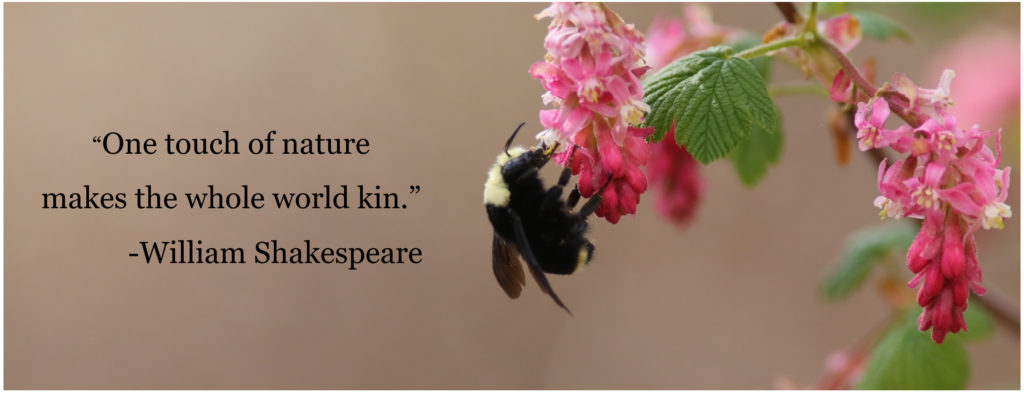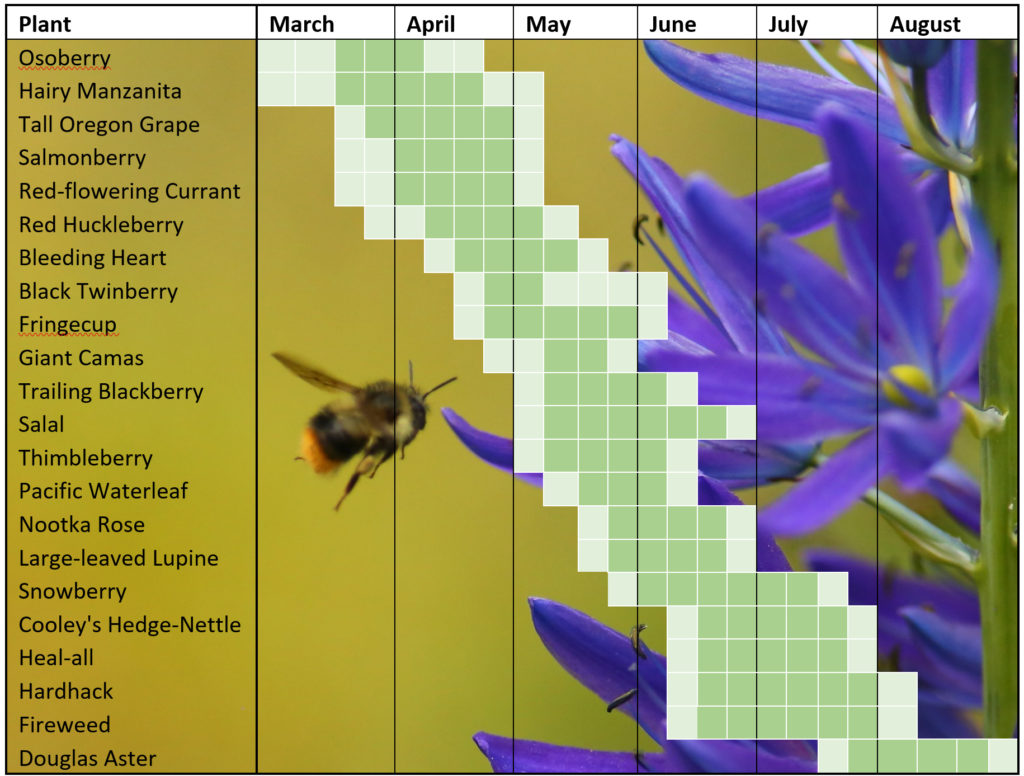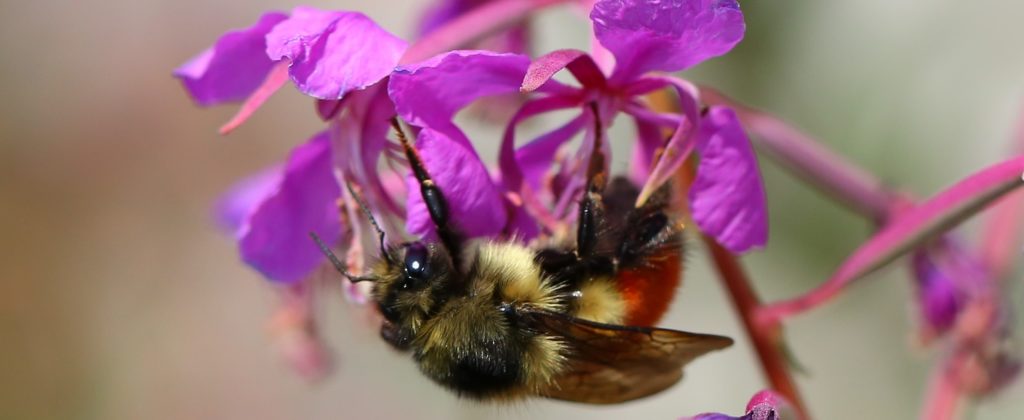
The beauty of a flower has long been the subject of human admiration, but there is good reason to believe that large colorful petals are even more beautiful to bees, butterflies, and other pollinators that depend on fragrant floral nectar and nutritious pollen for survival. Most bees for example, see a broader spectrum of color and have a much keener sense of smell than humans. Plants spend considerable energy growing showy flowers and creating sweet nectar to lure insects. So what do the plants get in exchange? The same thing that drives many poets… the hope of spreading their genes. Flowering plants depend on insects to carry pollen from one flower to the next. Without these insects, flowers would wither, barren and without fruit. You can thank a bee for every apple, pear, and blueberry you eat.
Bellingham is home to scores of native pollinators as well as several introduced species such as honeybees. Bumble bees are perhaps the most important group of native pollinators because they pollinate hundreds of species of flowers throughout the entire spring and summer. Habitat alteration, pesticide use, and insect diseases have all negatively impacted bumble bee populations in recent years, significantly reducing some bumble bee populations and the pollination services they provide. These declines can be addressed at many levels, including protecting natural flowering plant habitats, limiting use of neonicotinoid pesticides in all settings, restricting importation of non-native pollinators that may be carrying bumble bee diseases, and creating protected native plant habitats in urban and suburban areas such as parks, roadsides, and private gardens.
Enhancing your yard with native flowering plants is one of the easiest and most effective ways to create conditions that support bumble bees. Not only are native plants good for the bees, but they also require less work, as native plants are generally better adapted to our dry summers and wet winters. The most important consideration in pollinator gardening is that bumble bees have access to a continuous supply of pollen and nectar from late March to late August.
The tables below feature the flowering times of our lowland bumble bees’ favorite plants, as well as information about the preferred habitat for each of these plants. Use this information to select a suite of plants that can thrive in your space and offer a continuous supply of pollen and nectar for bumble bees.
Bumble Bee Friendly Native Plant Flowering Times

Selecting The Best Plants For Your Space And The Bees
| Plant (For more info click link to see USDA Plant Guide) | Form | Height (ft) | Soil Moisture | Shade Tolerance (Sun, Partial Shade, Shade) | Attractiveness to Bumble Bees (10 = very attractive) |
| Osoberry (Oemleria cerasiformis) | Shrub | 6-8 | middle | Su, PS, Sh | 5 |
| Hairy Manzanita (Arctostaphylos columbiana) | Shrub | 3-5 | very dry | Su | 9 |
| Tall Oregon Grape (Berberis aquifolium) | Shrub | 2-6 | dry | Su, PS, Sh | 8 |
| Salmonberry (Rubus spectabilis) | Shrub | 5-7 | mid-wet | Su, PS, Sh | 10 |
| Red-Flowering Currant (Ribes sanguineum) | Shrub | 4-8 | mid-dry | Su, PS | 7 |
| Red Huckleberry (Vaccinium parvifolium) | Shrub | 5-7 | middle | Su, PS, Sh | 7 |
| Bleeding Heart (Dicentra formosa) | Perennial | 1 | middle | Su, PS | 7 |
| Black Twinberry (Lonicera involucrata) | Shrub | 5-7 | wet | PS | 7 |
| Fringecup (Tellima grandiflora) | Perennial | 1-2 | middle | PS, Sh | 6 |
| Giant Camas (Camassia leichtlinii) | Perennial | 2-3 | mid-dry | Su, PS | 7 |
| Trailing Blackberry (Rubus ursinus) | Shrub | 1 | Middle | Su, PS, Sh | 7 |
| Salal (Gaultheria shallon) | Shrub | 3-5 | mid-dry | Su, PS, Sh | 7 |
| Thimbleberry (Rubus parviflorus) | Shrub | 3-5 | Middle | Su, PS | 7 |
| Pacific Waterleaf (Hydrophyllum tenuipes) | Perennial | 1 | Mid-wet | Su, PS | 8 |
| Nootka Rose (Rosa nutkana) | Shrub | 4-6 | wet-dry | Su | 5 |
| Large-Leaved Lupine (Lupinus polyphyllus) | Perennial | 2-3 | dry | Su | 8 |
| Snowberry (Symphoricarpos albus) | Shrub | 3-4 | middle | Su, PS | 9 |
| Cooley’s Hedge-Nettle (Stachys cooleyae) | Perennial | 3-5 | mid-wet | Su, PS | 7 |
| Heal-All (Prunella vulgaris) | Perennial | 1 | mid-dry | Su | 9 |
| Hardhack (Spiraea douglasii) | Shrub | 5-7 | wet | Su | 6 |
| Fireweed (Chamaenerion angustifolium) | Perennial | 4 | middle | Su | 9 |
| Douglas Aster (Symphyotrichum subspicatum) | Perennial | 3-4 | mid-wet | Su | 4 |

Non-Profit Native Plant Sales
Whatcom Conservation District https://www.whatcomcd.org
The annual WCD sale is the most economical source for bare root plants, as well as a selection of potted plants. Plants are available from both the WCD and other vendors on the day of the sale. Order early online from WCD for the best selection of plants. Potted plants sell quickly.
Koma Kulshan Chapter of the Washington Native Plant Society https://www.wnps.org/native-gardening/plant-sales
Held in late April or May, the annual sale has many species available in 4” to 5-gallon containers.
Salal Chapter of the Washington Native Plant Society
16650 State Route 536, Mount Vernon, WA 98272
https://www.wnps.org/native-gardening/plant-sales
Their sales are in the spring and fall at the Salal Native Plant Display Garden. They offer an extensive array of native plant species.
Local Nursery Sources for Native Plants
Cloud Mountain Nursery
6906 Goodwin Rd, Everson, WA 98247
https://www.cloudmountainfarmcenter.org/
Ph: (360) 966-5859
Small but nice collection of native plants.
Clark’s Native Trees and Shrubs
3130 SR 530 NE, Arlington, WA 98223
Ph: (360) 435-9473
Mostly trees and shrubs, but check the website for other plants. Best to order online and then pick up. Clark’s Nursery is strictly wholesale.
Namasté Gardens
17421 Turtle Lane, Bow, WA 98232
Ph: (360) 724-3141
Interesting selection of common and unusual native plants.
Plantas Nativa
315 East Champion Street, Bellingham, WA 98225
360-715-9655
Almost exclusively Washington native plants. Unusual and hard-to-find plants.
Fourth Corner Nursery
5652 Sand Road, Bellingham, WA 98226
360-592-2250
https://fourthcornernurseries.com/
They have a good variety of potted plants and bare root stock.
If you find yourself in other parts of Washington, check out this Washington Native Plant Society website for nurseries east of the cascades and points south: https://www.wnps.org/native-gardening/sourcing
More Information
The Bellingham City Council voted to become a Bee City USA sponsor in 2020 to help preserve pollinator species throughout the city.
For more information on Native pollinators visit the Xerces Society online.
The WTU Herbarium at the University of Washington’s Burke Museum is a great resource for learning more about native plants in Washington State.
